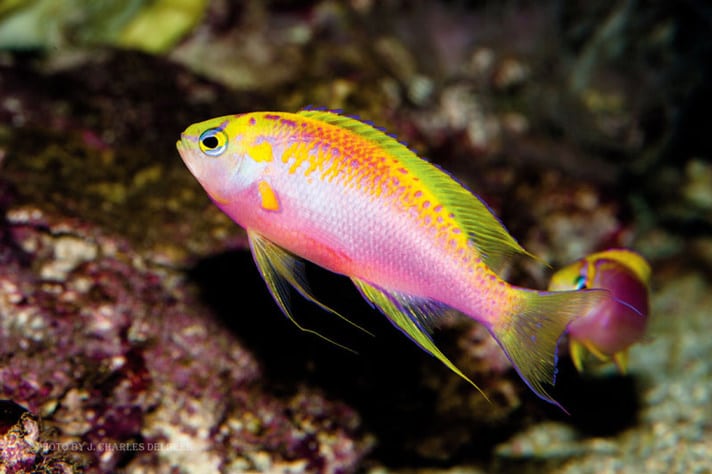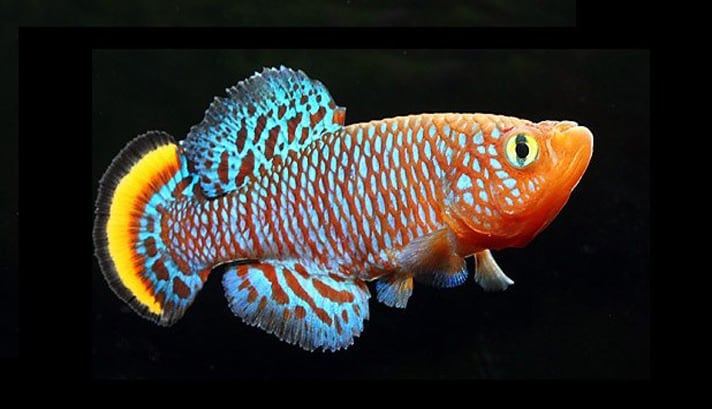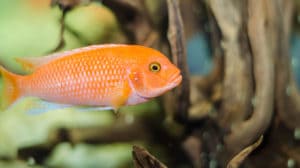One of the most unforgettable sights when one dives on an Indo-Pacific reef are the immense clouds of fish that can be encountered along drop-off edges and over the tops of coral outcroppings called bommies. These clouds are often a mixture of fish species, but those most often encountered and that make up the greatest number are the fairy basslets, also known commonly as anthias. With their sheers numbers and bright colors, large schools of several thousand can leave a lasting impression.
Anthias are shoaling fish, with some species forming groupings of several thousand while others form much smaller groupings of a few dozen. They spend the day swimming above the reef facing into the current where they are constantly feeding on passing planktonic prey, such as zooplankton and fish eggs. At dusk they retreat into the reef for the night, only to re-emerge at sunrise.
In general, anthias make excellent candidates for reef aquaria as they are strictly planktivores and as such will not harm corals, clams, anemones or crustaceans. Since they are planktonic-feeders they tend to remain out in the open swimming in midwater so they are always visible. Their hardiness varies from extremely hardy to quite delicate, depending on the species. With some exceptions they can be kept in a group, though some aquarists prefer to keep individuals. They tend to be relatively peaceful with other inhabitants but can exhibit intraspecific and interspecific aggression, the reason for which we will examine shortly. The males are more colorful than females. They readily spawn in aquaria, but they have yet to be successfully reared due to the extremely small size of their eggs and subsequently small newly hatched larvae.
In this article we will examine these fishes more closely, what makes them unique, why they are often considered to be challenging, and discuss some of the more commonly available species with respect to their captive care.
Anthias Taxonomy
The common name anthias stems from the early reports of these fishes, which were first described from specimens collected in the Mediterranean in the 1700s. Subsequently species in the Pacific and Indian Oceans were originally placed into this genus, but it was eventually determined that these should be placed into other genera due to a number of anatomical differences.
Today all “anthias” species are placed in the family Serranidae along with groupers, and are further differentiated into the subfamily Anthiinae. There are currently 27 genera recognized in this subfamily, with the Atlantic and Mediterranean forms remaining in the genus Anthias. Most of the species we call “anthias” actually belong to the genus Pseudanthias, which this article will focus on. A few other genera are worth noting and will be highlighted in the sidebars.
Anthias Distribution in the World’s Oceans
Anthiinae are found in all the major tropical oceans of the world extending from the shallows to depths of more than 1,000 feet. Those available in the aquarium trade, namely the Pseudanthias, are mostly found in shallower depths of coral reefs from less than 10 feet to 180 feet. From the Red Sea to the Mediterranean they are indeed a very widespread group of fishes. By far the tropical Indo-Pacific is the major source for the trade with species commonly coming from Fiji, Indonesia, Hawaii, the Philippines, Japan, Vanuatu, the Solomon Islands, the Maldives and Australia.
Anthias Habitat
Anthias are found primarily on coral reefs in areas that experience periodic strong currents or tidal cycles. This usually means along reef crests and along seaward-facing reef faces of drop-offs. Those species found in deeper water do not receive the same sort of high-energy water motion found in shallower water, but nonetheless they do experience currents.
Most anthias swim off the reef surface high in the water column where they can swim in the plankton-rich waters and feed. Some species, however, such as the fathead anthias (Serranocirrhitus latus), are found very closely associated with the reef face at depth, often swimming within crevices or underneath overhangs, not swimming far out in the open.
Population Structure of Anthias
Anthias typically are found in mixed shoals of males and females, as well as immature females and males. The shoals vary in size depending on species with some, such as Pseudanthias squamipinnis, P. huchtii and P. tuka, numbering in the thousands, whereas some, such as P. pleurotaenia, number less than a dozen. Typically the ratio of male to female is quite low with just a few males to several dozen females.
The most interesting aspect of anthias is that they are sequential hermaphrodites; that is they start off as one sex but can change into the other sex as they get larger and more mature. In anthias, they begin their adult life as female but under certain circumstances they can begin to develop male coloration and eventually their ovaries degrade and testis form. Several mechanisms can trigger this change. If a resident male dies or is otherwise removed from the population, the largest females begin to change into males, or if the ratio of males to females gets too low, the largest females begin to change.
The reason for this is that when males are present they constantly harass the females, and the larger females harass the smaller fish in the shoal. In this manner, hormones in the fish are kept in balance. When a male is removed, the pressure on the largest females ceases and the hormones that control sex change can then kick into gear. Within a few weeks, a female then looks like a male and can eventually begin to function as one.
It is this controlled aggression that makes keeping groups of anthias in home aquaria challenging. Some species exhibit this aggressive behavior more strongly than others, with the larger species tending to be more aggressive than smaller species. Unfortunately the degree of aggressiveness also appears to be linked to the relative hardiness of the species.
Some suggestions to lessen this aggression are to feed frequently (three or four times a day), keep larger groups of primarily females of equal size with a single male, keep only a single male or have a really big tank in excess of 1,000 gallons.
Anthias Compatibility With Other Species
Most anthias species tend to leave other groups of fish alone. As mentioned, intraspecific aggression can be high, and aggression between different species of anthias can also be high, particularly between males of one species and females of another where the females’ coloration is similar. Avoid housing anthias with large, more boisterous fish, such as large angels, triggers and the larger, aggressive wrasse species.
Some species of anthias are considered jumpers, such as P. pleurotaenia, so open-top fish aquariums should be carefully reconsidered if anthias are to be a featured element.
Ideal Water Quality for Anthias
Because many species of anthias are found in shallow, brightly lit, fast-moving waters, the need for oxygen in these small, highly active fishes is high. Assure that your water is at least above 90 percent oxygen saturation — closer to 100 percent is better. This can be achieved through protein skimming, surface water turbulence, having a good surface area to volume ratio (use a wider, shorter tank), good gas exchange and by the use of overflows.
Nitrogenous wastes, such as ammonia, nitrite and to a lesser extent nitrate, should be close to 0 ppm. The typical water-quality parameters found in live coral tanks for calcium, alkalinity and pH provide an excellent environment for anthias. Temperature should be within the normal ranges for most reef aquaria (78 to 84 degrees Fahrenheit). Deeper-water species may require lower temperatures in the range of 68 to 74 degrees Fahrenheit, depending on where they originated from, e.g., main islands of Japan, which is a cooler water area out of the tropical zone.
Breeding Anthias
Male and female anthias are sexually dimorphic, making them easy to sex. Males tend to be larger, more colorful and usually have an elongated third dorsal spine. The caudal fin in most species often develops streamers on the tips. In some species such as P. tuka and P. dispar, the male also develops an extension on the upper lip causing it to have a more pronounced tip.
Anthias readily breed in aquaria and may do so nightly. Around dusk the males begin to court the females by “dive bombing” them, rushing toward them from above and then angling sharply back upward. Eventually the female joins the male on his upward swing and at the apex they release eggs and sperm, at which point the deed is done and the eggs become a part of the plankton. Unfortunately, given the confines of a fish aquarium, the eggs are usually quickly eaten.
Due to the small size of the eggs the larvae are extremely primitive when hatched, lacking eyes and a visible mouth. Therefore rearing this species has proven to be very challenging but not impossible. The Rising Tide initiative working out of the University of Florida’s Tropical Aquaculture Laboratory has targeted Pseudanthias bartlettorum as a species they will be working on rearing.
Feeding Anthias
Anthias are midwater feeders, picking food items from the passing water as they swim to maintain position over the reef. They prey primarily on large copepods and other planktonic prey. Because they are so active, they require a constant supply of food. Therefore frequent feedings are best, on the order of three or four times per day. This can be achieved with an auto-feeder setup or by using some of the commercial automatic dry-feed dispensers on the market. An attached refugium might provide a constant input of planktonic foods in the form of larval crustaceans and polychaetes that reproduce in such systems. However, unless there is a low population of fish and a very large refugium the likelihood that such a setup would provide enough food is doubtful.
In aquaria live foods like copepods, rotifers, Mysis and newly hatched Artemia (baby brine shrimp) are all excellent foods to get many of the smaller- to medium-sized anthias species feeding. Finely chopped frozen Mysis, shaved clam tongue and frozen prawn, and micropellet feeds are also excellent foods for anthias, providing a more varied diet and reducing the reliance on live foods. For larger species like P. pleurotaenia and P. pictilis, whole frozen Mysis will also be readily taken as will some of the smaller pellet feeds available. In order to maintain their bright colors, anthias should be fed foods that have been enriched with carotenoids, such as astaxanthin and canthaxanthin. One such product is Cyclop-eeze.
Purchasing Anthias
Anthias tend to be rather disease-resistant once they are properly acclimated to the aquarium and feeding well. The key is to get them in good condition and to offer them a variety of foods in sufficient quantities daily. Common ailments include saltwater ich (Cryptocaryon) and parasitic copepods and flatworms. Careful observation of a specimen before purchasing can go a long way to reducing the risk of having a diseased fish. Look for fish that have excellent color and a well-rounded forehead above the eyes. It should not be sunken or pinched in. The fish should be active, not hovering in a corner or swimming erratically.
Some anthias come from deeper water and, if not acclimated properly when they are brought up, may exhibit swim bladder issues. The telltale sign of this is that the fish will appear “floaty,” meaning it has difficulty staying level in the water and is constantly swimming with its head down in a jerky manner.
If you want to get a group of the same species, be sure to select primarily, or even only, females of about the same size, and just one male. More than one male will result in excessive aggression in most home-sized aquaria unless it is quite large (250 gallons or more).
Anthias In The Home
Let’s now take a look of some of the more commonly encountered species and discuss some tips for keeping them in your aquarium.
Lyretail anthias, Pseudanthias squamipinnis
Found from the Red Sea to Fiji and as far north as Japan, this is by far the most commonly imported anthias species. Males can reach up to 4.7 inches (12 centimeters), with females being slightly smaller.
There is significant coloration differences between populations across its range, with those from Fiji generally considered the most brightly colored. Males have an elongated third dorsal spine, elongated tail fin extensions and are colored anywhere from purple to red and violet with a large purple/violet spot on the pectoral fin. Females can be a drab yellow to brilliant orange with a red line edged in purple running diagonally downward from the eye to the base of the pectoral fin.
This is probably the most commonly imported species with good reason. Not only is it colorful, but it is also one of the hardiest species. They tend to be aggressive so only one male per tank should be the maximum, along with several females, a ratio of 1:5 is a good starting point. They should not be kept with less aggressive anthias, fairy and flasher wrasses or dart gobies.
Redcheek anthias, Pseudanthias huchtii
Commonly found in Indonesia and the Philippines, it is not as colorful as other species, but it is among the hardiest. Males have a bright red stripe extending from the eye down to the base of the pectoral fin, the body is a yellowish green overall with red and blue fin margins, an elongated third dorsal spine and tail fin trailers. Females are yellowish orange to greenish orange and the eye stripe is a fainter orange. They can also often be found schooling with lyretail anthias.
Another aggressive species, one male to eight females is a good starting point. In tanks less than 180 gallons, only one male is recommended.
Squareblock anthias, Pseudanthias pleurotaenia
This spectacularly colored fish is found from the Philippines down to Australia and as far east as Samoa. It is a larger species, with males reaching up to 8 inches in length. The males have a characteristic purple square on their sides and the body is a mixture of reds, pinks, purples and blues. Females are slightly smaller and tend to be orangish with an orange stripe from the eye to the pectoral fin extending along the belly of the fish outlined in red or pink. It is most common in deeper water below 90 feet along reef slopes and within caves and crevices.
Due to their large size they need a large aquarium, and it is best to have a single male and up to eight females. They tend to do best in dimly lit aquaria or aquaria that have numerous hiding places where they can retreat into dimmer areas.
Redfin anthias, Pseudanthias dispar
Found primarily in the western Pacific eastward to Samoa, the redfin anthias is a smaller species. Males reach a maximum size of a little under 4 inches and females less than that. This is another relatively shallow water shoaling species and as such it does well in brightly lit reef aquaria.
Tanks less than 100 gallons should not house more than one male with six or more females. Larger tanks can house more males. This species is often found schooling with the lyretail anthias and is best housed with non-
aggressive tankmates.
Yellow-stripe anthias, Pseudanthias tuka
Another commonly imported anthias, the males reach almost 5 inches in length and are primarily purple with a tinge of yellow or orange along the throat. Females have a bright yellow stripe that extends along the back from the head onto the tail, and both edges of the tail are yellow. Found from Indonesia to Japan, this species is often confused with the purple queen anthias, P. pascalus, but the males of the species are entirely purple and the females lack the yellow stripe.
This is a delicate species. If healthy individuals are acquired and they are fed small amounts of planktonic food several times per day, they can be quite hardy fishes.
Deepwater Anthias
A number of spectacular anthias are found in waters considered deep by most of us, between 100 and 300 feet. Several of these species are coming into the trade from places such as Japan and Hawaii. Recently fishes from the genus Odontanthias (formerly Holanthias) have come into the trade.
I saw my first Odontanthias species, O. borbonius, while on a collecting trip in Palau in 1997. Dr. Richard Pyle was doing rebreather dives to more than 300 feet and brought up a spectacularly colored adult male. In Hawaii he also collected the Hawaiian endemic species O. fuscipinnis of which he donated several specimens to the Waikiki Aquarium in the late 90s, where they are still on display. These are a large, stocky species, with males reaching over 7 inches in length and being spectacularly colored.
Recently, juvenile P. borbonius have become available in the trade. Being deeper-water species, provide them with cooler water between 68 and 74 degrees Fahrenheit in a dim tank. While they can be kept in brightly lit reef aquaria, they will tend to remain close to or hide within the rockwork. The O. fuscipinnis I have had experience with were kept in dimly lit aquaria and swam in the open constantly.
Other deepwater species include Pseudanthias randalli, Pseudanthias ventralis, Tosanoides spp.
Beauties For The Tank
The anthias present some of the most beautiful species available in the aquarium trade, and their shoaling nature makes them attractive inhabitants for marine aquaria. With proper handling, and abundant food and space, they can provide a wondrous backdrop to any aquarium.
Following is a breakdown of Anthiinae genera and the number of species in each. Those with an asterisk can be found in the aquarium trade. However, by far the most commonly encountered genus is Pseudanthias, followed by Plectranthias, Serranocirrhitus, Luzonichthys, Odontanthias and Nemanthias.
Family Serranidae
Subfamily Anthiinae
Genera
Acanthistius 11 species
Anatolanthias 1 species
Anthias* 15 species
Caesioperca 2 species
Caprodon 3 species
Dactylanthias 2 species
Epinephelides 1 species
Giganthias 2 species
Hemanthias* 5 species
Holanthias* 2 species
Hypoplectrodes 8 species
Lepidoperca 10 species
Luzonichthys* 6 species
Meganthias 4 species
Nemanthias* 1 species
Odontanthias* 15 species
Othos 1 species
Plectranthias* 47 species
Pronotogrammus* 3 species
Pseudanthias* 61 species
Rabaulichthys* 4 species
Sacura* 4 species
Selenanthias 3 species
Serranocirrhitus* 1 species
Tosana 1 species
Tosanoides* 2 species
Trachypoma 1 species
By: Chewy Editorial
Featured Image: By J. Charles Delbeek
Share:









